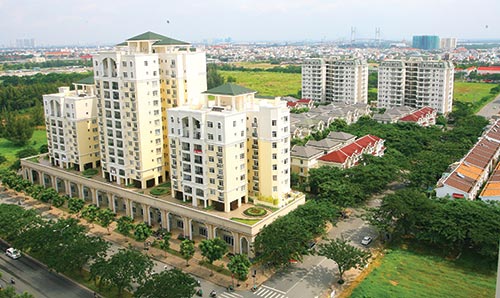Mythbusting green building costs

The Vietnam Green Building Council argues that despite the cost-associated scare stories, green buildings
deliver productivity benefits over decades
Whether a building is rated based on its energy-saving solutions, use of green materials, smart building management or environmentally-friendly design, the truth is that the country has failed to embrace these features on a large enough scale.
According to Yannick Millet, former executive director, and now technical advisor to the Vietnam Green Building Council (VGBC), the council has tried to convince investors that the economic value of a building needs to be looked at from a broader point of view that incorporates the whole life cycle from design to construction, use and finally disposal, before drawing hasty conclusions over what constitutes good value.
A green building’s first and foremost quality is to save energy, water and other resources while satisfying functions.
“Therefore, the first benefit an investor can receive from a green building would be lower operating costs, which is especially important now that energy prices in Vietnam are increasing,” said Millet.
He added that green buildings also benefit the day-to-day users, with fresh air, quiet and well-lit working spaces which aid productivity. As a result, employers can enjoy a better quality of work and productivity, which translates directly into improved profitability over the course of decades.
Cost considerations are often the biggest challenges that hinder the upscaling of green buildings in Vietnam.
At present, misperceptions abound that green building costs could run to as much as 10-29 per cent more than conventional buildings. This has turned developers and owners away from green initiative building.
However, VGBC argues that costly green buildings are a myth and that building green is cost-effective today, particularly for those projects which start green design early in the process.
Millet further explained that green buildings are designed to be resource efficient, environmentally-friendly and healthy for occupants throughout their 50-70 yearlife cycle.
“They’re there to benefit both the environment as well as the people using it, and in an economical sense, they benefit the investors too,” said Millet.
However, green buildings face a negative PR campaign, with opponents claiming that such buildings could cost 30 per cent more or sometimes even 80 per cent more than normal constructions.
Tran Van Thanh, executive director of the VGBC which has attempted to promote green building since its establishment in 2007, said that this was a myth but only reality would prove the detractors wrong.
Data from developed green construction industries abroad have proven that sustainable projects, across all project types, can be found at every price point and on average cost no more than projects lacking sustainability goals.
Green standards have not only meant almost no difference in terms of cost, but have also brought much needed marketing benefits for flagship green buildings.
Economic growth in Vietnam has obviously been accompanied by a boom in construction, with the industry responsible for a large proportion of the country’s CO2 emissions.
According to the US Energy Information Administration, the average energy consumption of the housing sector globally stands at 24 per cent. However, this percentage in Vietnam was more than double at 54 per cent, which stands in sharp contrast to the average 33 per cent in Southeast Asia region.
Green building trends obviously embrace constructions from the design step or in the re-design of existing buildings to maximise their energy saving capacity.
The green building concept was applied in the Sheraton Hanoi Hotel via the installation of a new eco-friendly water-pumping system and residential developments such as Ocean Park in Hanoi or the Majestic Hotel in Ho Chi Minh City.
What the stars mean:
★ Poor ★ ★ Promising ★★★ Good ★★★★ Very good ★★★★★ Exceptional
Latest News
More News
- The Kross ascends in Ho Chi Minh City's business heart (October 10, 2025 | 17:16)
- ESG-driven sustainability to define Vietnam’s green real estate (September 19, 2025 | 11:35)
- Tan Thuan Tower open for high value-added and innovative tenants (September 10, 2025 | 10:00)
- The new home of modern business at Hanoi's Starlake (August 19, 2025 | 08:00)
- Forum focuses on financial solutions for ESG in real estate (June 18, 2025 | 12:12)
- Frasers Property Vietnam moves towards green real estate leadership (May 08, 2025 | 11:25)
- Keppel collaborates with leading brands to enhance urban living in Vietnam (April 04, 2025 | 09:26)
- Strengthen partnership and efforts to promote zero energy buildings in Vietnam (February 26, 2025 | 17:31)
- Haus Dalat ESG real estate project holds opening ceremony (February 24, 2025 | 11:12)
- Best golfers awarded at Swing for the Kids 2024 (October 13, 2024 | 08:00)


















 Mobile Version
Mobile Version